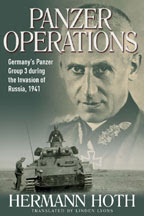
Title:
Panzer Operations
Author:
Hermann Hoth
ISBN:
978-1-61200-269-9
Publisher:
Casemate Books
Hardcover
Pages:
215
Photos/maps:14/16
Hermann
Hoth is considered by many to have been one of the greatest armoured commanders
serving in the German Army during the Second World War. A veteran of the First
World War, he commanded Panzer Group 3 during the initial drive into Russia,
following which he was given responsibility for 17th Army and
subsequently 4th Panzer Army. Despite being the recipient of the Swords
to the Oak Leaves to the Knights Cross of the Iron Cross for exceptional
bravery and leadership, he was blamed by Hitler for the loss of Kiev in Nov
1943 and relieved of command.
In
1956, Hoth drafted his memoires relating to the operations of 3 Panzer Group
from the commencement of Barbarossa (June 1941 - the invasion of Russia) until
October, 1941. This book is the first translation of said memoirs into english
and represents an outstanding assessment of not only the operational command of
armoured forces but also the interaction (both positive and negative) between
Hitler, the strategic German Army command and the operational units. His
observations on the delineation between ‘strategic’ and ‘operational’ lines of
command as well as the overarching political considerations driving decision
making are both relevant and insightful even today.
Throughout,
Hoth centres his assessments on the teachings of such giants of military
thought as Scharnhorst, Clausewitz and Moltke and the necessity to learn from
the lessons of the past. He also assesses the climate within which the German
military planners operated at the strategic level – namely one in which Hitler
continuously fluctuated in clearly identifying the main objective of the
campaign: the destruction of the Red Army and the capture of Moscow or the
economic crippling of the Soviet Union; the challenge therein being the fact
that one is clearly military and the other socio-economic in nature. The
vacillation between the two would hamper operations throughout the early days
of the campaign.
The
meat of the book however, centres upon the effective command of armoured forces
in the field and the best use that may be made of them. He draws extensively
from the pre-invasion assessments made of the Soviet Union, its transportation
infrastructure, military and anticipated response to invasion. He also
discusses various invasion planning courses of action that were developed by
the German High Command. These are fascinating as they are outstanding examples
of high level planning and the process by which they were considered and
rejected. Included was an option to combine all armoured and motorized infantry
divisions into one massive mailed fist that would drive forward from a start
point on the northern flank of Army Group Centre directly towards Leningrad
thereby cutting off Russian Baltic forces and securing the Northern flank.
Following this, the mobile forces would drive southwards cutting off Moscow and
the Russian Army from its resupply and reinforcement options from the Urals and
forcing it to fight on reversed fronts; all this while Army Group’s Centre and
South would drive inexorably forward pinning Russian units in place. Such an
example emphasizes the bold and risk accepting nature of effective armoured
operations.
The
main body of the text traces the operations of Panzer Group 3 during the
initial period of the Operation Barbarossa and the factors that affected his decision
making. In his conclusion, Hoth encapsulates the essence and fundamental
tenants of the operational command of mobile units and what are the key factors
in the achievement of success (in relation to the campaign in Russia). Additionally,
he reiterates the absolutely critical requirement to clearly establish and
maintain the aim of operations regardless of the temptations that may present
along the way. He includes in his work a series of annexes outlining key
assessments and orders that he received and drafted during the course of the
campaign. He also includes a discussion on the decision to undertake the final
drive on Moscow in October, 1941 incorporating/emphasizing the responsibility
of the commander in the decision making process.